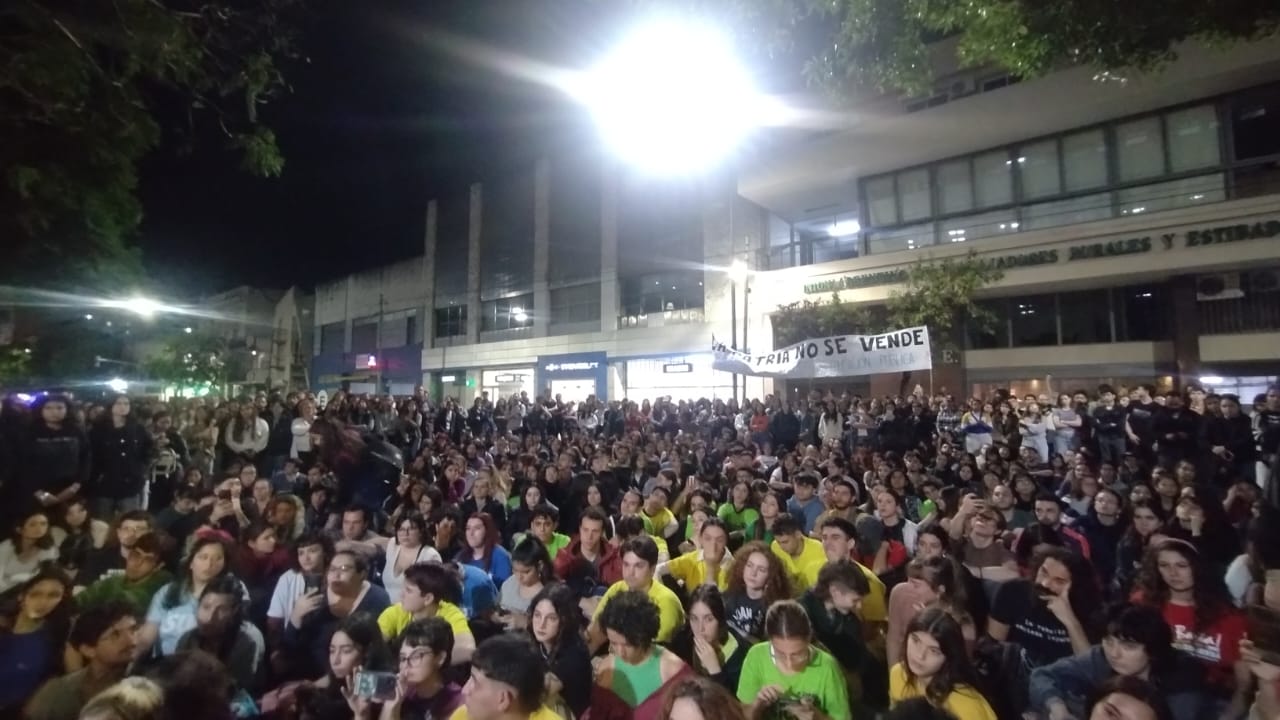
In the last few hours, the government’s offer of 70% in March and another 70% in May for the operating expenses of national universities was known, which, although it remains far behind the 280% inflation rate and does not offer anything to teachers whose salaries have been falling, expresses the government’s fear that the university mobilization of April 23 will awaken more than just the student movement.
Students, teachers and non-teachers from the National Universities begin to move throughout the country. In recent days, dozens of public classes, hugs, mobilizations, festivals, cacerolazos and assemblies filled the streets and patios of educational institutions along with students, teachers, non-teachers and sectors of workers who have been fighting. The educational struggle that is being born can deal a hard blow to Milei and encourage the struggle of all sectors affected by her plan.
Something is brewing…
The UBA had public classes in several faculties (such as Philosophy and Letters where the street was closed for five days), assemblies full of participation (such as Psychology where the management of the center – EDI / Franja Morada – had to join in when they saw the call massive) and hugs to faculties and hospitals that depend on the university such as Medicine, Clinics or Exactas.
In Mendoza, at UNCuyo, there was a massive mobilization where thousands of teachers, students and non-teachers and an interfaculty participated. Something that has not been seen for a long time. The provincial government’s response? Fine the FADIUNC teaching union by one million pesos.
In Córdoba, from the Ate-Conicet assembly and the UNC Arts and Philosophy students assembly, a festival was held where 1,500 people participated. The proceeds were donated to the fight fund for the state’s laid-off workers.
In Rio Negro and Neuquen, where the University of Comahue is located, they have just held public classes within the framework of the National Teachers’ Strike last week. A Network is being organized in defense of public education.
In the UNLP, the organization continues to grow in assemblies, driven by those who self-organize to confront Milei’s plans. On Thursday alone there were assemblies in 8 of the 17 faculties of the University.
The air of conflict is beginning to arrive in the suburban universities. In the South zone there were assemblies of 250 people in UNAJ, 150 UNQ, 150 in UNDAV, 300 in UNLa, where a flag-off was also held with 400 people including teachers and students. In the northern zone, on Thursday there were mobilizations of more than 500 people at the Universidad Gral. Sarmiento, San Martín and at the University of Moreno. In addition, hundreds of students have been organizing assemblies also in UNTREF, UNLU and UNPAZ. There was even an assembly of 300 at UNLAM, and self-convened assemblies at UNLZ and UNaHur.
In Jujuy, the streets were also filled with the torchlight march and public classes promoted by the UNJu.
All these are just some examples. Something starts to change. The student movement is waking up and can motivate other sectors to come out against this government.
What is our fight?
Milei seeks a country model that is much more dependent on foreign capital, where job insecurity, poverty and extractivism increase. For that, she needs a university model where fewer and fewer of us can access it and where education is thought to serve the business of entrepreneurs. He wants to deepen the growing trend of commercialization that our education and science has been suffering from, which for years has only benefited big businessmen and the IMF.
As if they were two separate things, Emiliano Yacobitti, the vice-rector of the UBA, says in the media that the march on April 23 is not against the government but only for the university. This is because he belongs (like many other rectors and the Purple Strip) to the UCR. That he is “collaborating” with Milei. Many radical deputies and senators are going to vote for the new Omnibus Law, so that the looting of pensions, salaries, social plans and all the country’s natural resources continues. They also want a labor reform to make our jobs more precarious or the ones we can get when we graduate.
The objectives of the Peronists and radicals who run the Universities and the provinces are very different from ours. They seek a budget increase regardless of where they have to sign, they are willing to vote on those laws in exchange for a few crumbs. For some reason they have not yet called a session in the Chamber of Deputies to tear down the DNU. We cannot allow it. We want more budget but not at the cost of taking bread out of the mouths of retirees, not at the cost of prohibiting the right to strike of our teachers, turning education into an essential activity. Not at the expense of salaries and making our lives precarious and leaving thousands of classmates out of university.
Most of us who study also work. If we can’t make ends meet, we can’t pay rent or transportation, not only can we not educate ourselves, we can’t live either. The university cannot be saved alone, it has to be with everyone inside and with a perspective that proposes putting our knowledge at the service of society and not the market. To confront the attack on the university, Milei’s entire plan must be destroyed.
Shouldn’t we be the ones to debate where we want the money for education to come from? A debate about the government’s purchase of warplanes circulated widely on social media. Is there money for that? But not for universities? Not for retirees? Not for workers? Businessmen like Galperin are given tax benefits, they increase the salaries of senators and government officials like Manuel Adorni or Karina Milei, but they cut universities. They just gave the IMF 5.5 times the university budget. There is silver…
Their priorities are clear, but we fight for others. We can only trust in our own strength along with that of millions of workers. We have to know who our allies are for this fight and who wants to use us to take care of their kiosks. We need as much unity as possible to bring down Milei’s entire plan. We, the students, teachers, non-teachers and workers, have to set the rules.
It is worth asking why some groups, which always talk about a Human Argentina or the Great Homeland, are not being part of warning about this problem, of unmasking the use that the leaders want to make of our mobilization. In some assemblies, even, such as the self-convened one in Social of the UBA, La Mella abstained from rejecting the omnibus law, the labor reform and the DNU and refused to demonstrate so that the authorities turn on the light and do not give in to self-adjustment in Why? Do the faculties agree with Milei’s measures? At the Faculty of Arts of the UNLP, where they lead the student center, they refused to hold an assembly before the 23rd, the students called themselves and did the same with the absence of the leadership. Furthermore, they have had a policy of dividing each sector that is fighting. Everywhere you look at it, it seems that they want to let the government’s adjustment pass, to “return” with Peronism on scorched earth in 2027, in the middle are those who do not have enough to eat or have to leave university. It is not for nothing that it is practically impossible to find their references in the streets or in the workers’ struggles.
Organize from below
Years of student centers that became the student paw of the authorities and forgot to be a tool of struggle can lead us to believe that we have to wait, that due to lack of experience it is okay to “lead us” from above. But the examples that are beginning to exist show that we have the possibility of recovering the best tradition of the student movement. Which in 1918 conquered university autonomy, in 1966 faced the Ongania dictatorship and caused it to fall after the milestone of Cordobazo, where in 1969 the students came out with the workers to confront the dictatorship. The one that in the 90s faced the Menemist Superior Law and in 2001 threw out the Minister of Economy, Ricardo Lopez Murphy, who had announced an adjustment to the university budget. That is the tradition that the student movement has in our country. A movement that knew how to build and establish ties with the workers and build a great force that can be overwhelming.
It is no coincidence that, every now and then, the president speaks of “Marxist indoctrination” at the University. The Onganía dictatorship in ’66 used similar arguments to attack higher education. For the lover of cloned dogs, everything that does not align with his ultra-capitalist liberal vision is equal to Marxism. But the shot could backfire. With so much talk about “communism” and “Marxism”, interest in Marx’s ideas increases in the first years of college and the editions of the Communist Manifesto from Ediciones IPS sell like hotcakes.
Throughout the country, swathes of students who got tired of waiting for the bus from their student centers and began to organize: FADU in Lucha at the UBA, the Posta Sanitaria in Buenos Aires and La Plata, the Network in defense of public education in UNCUYO, self-convened assemblies and WhatsApp communities in many universities. This has to be just the beginning for spaces of self-organization to flourish in the faculties that overcome the obstacles and rhythms that the student bureaucracies and the university regime want to impose.
In the march of the 23rd, let’s make visible all the self-convened spaces that arise in each faculty and university, along with the centers that want to fight against the entire Milei plan together with the workers. Let’s build a large inter-faculty assembly that brings together all those spaces independent of the authorities. Let’s coordinate in the same march and towards the future.
From the PTS Youth we form groups together with independent students with whom we are trying to develop the broadest self-organization in each faculty, in each university and convince of the fight to strengthen the university struggle and all struggles, making workers, neighborhood assemblies, students , social organizations hit with a single fist. We want to return to the best experience of the student movement, that of Cordobazo, that of the unity of workers and students that demonstrated that this is the way to succeed, with mass mobilization and self-organization, without any trust in bureaucracies, trust in our own strength and unity. They overthrew a dictatorship, we can bet on changing history, of the university and of the entire country.
In each university the student movement begins to re-emerge and the workers’ struggle arouses sympathy. We have to invite all of them, our family, friends, coworkers, to be part of the April 23 mobilization. And to be part, on the 27th, of the great Meeting that we are organizing together with workers who are facing layoffs such as those from GPS Airlines and state ones, neighborhood assemblies, social movements, human rights, environmentalists, the women’s movement, to debate how we face the Milei adjustment plan together with businessmen, IMF and governors.
If the present is about struggle, the future is ours.
Source: www.laizquierdadiario.com

